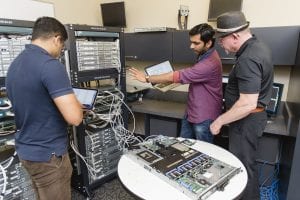Dr. MinJun Kim and his BAST Lab Team are an interdisciplinary research group developing new classes of Microbiorobotics, Nano/Microfluidics, and Nanopore Technologies for practical medical and biomedical applications

Imagine an army of microscopic robots entering a patient’s bloodstream and performing highly specialized tasks, such as localized drug delivery, minimally invasive surgical procedures, and enhanced medical imaging. This is the goal for Dr. MinJun Kim and his research team of students in the new, state-of-the-art Biological Actuation, Sensing, and Transport (BAST) Lab at SMU Lyle School of Engineering.
Dr. Kim joined SMU Lyle last fall as the Robert C. Womack Chair in Engineering and professor of mechanical engineering. His talents led to recognition as the first investigator to fully use flagellated bacteria – whose cells have a whip-like projection that allows them to move through bodily fluids – as micro-actuators in engineered systems.
The BAST Lab currently includes eight Ph.D. students eager to work with Dr. Kim. In addition, he has recruited eight SMU undergraduate students to the BAST Lab, who come from diverse science and engineering disciplines. “This nanotechnology applies to all majors including mechanical engineering, biochemistry, computer science and electrical engineering,” Dr. Kim says. “SMU undergraduates aren’t afraid to explore the challenges of a new field.”
Fellow faculty members referred some undergraduate students to Dr. Kim. “SMU’s collegial atmosphere provides open communication and collaboration among SMU Lyle faculty, SMU departments and administration to put students in the right places based on their research interests,” he says.
Daehee Kim ’16, one of Dr. Kim’s Ph.D. students, received his undergraduate degree in Mechanical Engineering from SMU Lyle. “Dr. Kim is a fantastic advisor whose innovative passion in combining biological research with engineering principles attracts students keen in both research fields,” Daehee says. “A pioneer in microbiorobotics and nanopore research, Dr. Kim seeks to develop the best scientific methods and data while enforcing optimal lab environments. My interest in the sciences persuaded Dr. Kim to offer me a position in his BAST research group dealing with flagellar forests. He is a great professor and motivates me daily to succeed.”
 Dr. Kim was named a senior member of the Institute of Electrical and Electronics Engineers (IEEE) last spring. This prestigious honor is received by only 10 percent of IEEE’s estimated 423,000 members in more than 160 countries. “This distinction bestowed upon Dr. Kim reflects the high standards established by IEEE to achieve such status,” says Dr. Ali Beskok, Mechanical Engineering Chair and professor, who sat on Dr. Kim’s master’s degree committee at Texas A&M University. “His outstanding contributions in the field of microrobotics having potential applications in nanomedicine underpin his level of scholarship and groundbreaking research.”
Dr. Kim was named a senior member of the Institute of Electrical and Electronics Engineers (IEEE) last spring. This prestigious honor is received by only 10 percent of IEEE’s estimated 423,000 members in more than 160 countries. “This distinction bestowed upon Dr. Kim reflects the high standards established by IEEE to achieve such status,” says Dr. Ali Beskok, Mechanical Engineering Chair and professor, who sat on Dr. Kim’s master’s degree committee at Texas A&M University. “His outstanding contributions in the field of microrobotics having potential applications in nanomedicine underpin his level of scholarship and groundbreaking research.”
The BAST Lab currently is researching four core areas for practical biomedical and medical applications, each with a distinct purpose:
Core One ‒ microbiorobotics, developed for manipulation and sensing, focuses on using microrobots for drug delivery by traveling through the bloodstream to different organs, and for minimally invasive surgery where the microrobots seek and destroy cancerous tumors or drill through clogged arteries.
Core Two ‒ synthetic nanopore fabrication and single molecule analysis, uses nanoscale instrumentation, the size of a small biological pore (a-hemolysin), as a high-speed and efficient detection system to analyze physical changes, within a one-millionth-of-a-second resolution, in DNA molecules, proteins and viruses like HIV. “Nanopore-based bio-instrumentation is crucial because there is no device to measure deformability of soft nanoparticles such as liposomes and viruses in real-time at nanoscale with single-particle resolution,” says Dr. Kim. “Eventually, we want to analyze more data on translocations through a nanopore, and understand the structural property of not only a single cell, but also a single molecule.”
Core Three ‒ biologically inspired metamaterials for nano/optoelectronics, focus on exploiting biomaterials such as bacterial flagella for use in nanoscale sensing devices. In addition to organic-based nanosystems, the BAST Lab is also synthesizing photon-to-thermal energy conversion nanosystems, such as gold nanorods and gold nanoparticles. One possible medical use of this technology looks at reducing bloodstream infections in hospitalized patients who have been on continuous medical catheters. The same technology could be applied on a larger scale, to create safe, self-sterilizing touchscreen computers for use in public areas.
Core Four ‒ microorganisms swimming at a low Reynolds number, are the unifying factor for all biologically inspired nano/microengineering, which is the transport and artificially guided movement of microrobots through all types of bodily fluids, such as blood, saliva and mucus.
The BAST Lab team emphasizes the synergistic nature of the research cores, acknowledging that advances in one core area drive development of the others. Their unifying component results in “biologically inspired nano/micro engineering.”
Dr. Kim compares SMU’s academic atmosphere to an Ivy League school, explaining that the research opportunities and high-quality students create a welcoming space for more collaboration between faculty and students. “Professors can more accurately identify the best students to assist in their research, and students are readily exposed to hands-on research experience, even at the undergraduate level,” says Dr. Kim.
“Dallas is a good clinical field for nanorobotics,” he says. “It’s the fourth-largest metro region in the U.S., and very well known for nanotechnology. This technology is currently led by Texas Instruments and UT Southwestern and is known for computational research. Our supercomputers, combined with other local universities, will create a new synergistic opportunity to support my ongoing research.”
 Dr. MinJun Kim, Professor, Mechanical Engineering, and Robert C. Womack Chair in Engineering
Dr. MinJun Kim, Professor, Mechanical Engineering, and Robert C. Womack Chair in Engineering
Email: mjkim@lyle.smu.edu
SMU Lyle Website: www.smu.edu/Lyle/Departments/ME/People/Faculty/KimMinJun
The BAST Lab at SMU Lyle is part of the SMU-NNFC-DREXEL Nano Co-op Research Center, an international collaborative research center, established in 2016 with Drexel, SMU and KAIST-NNFC, funded by the National Research Foundation of Korea Global Research Development Center (GRDC) program and the City of Daejeon. The BAST Lab is valued at approximately $5.4 million and has eight ongoing research projects funded by the National Science Foundation, the National Institute of Health, the Korea Evaluation Institute of Industrial Technology, and the National Research Foundation of Korea, among other diverse agencies sponsoring this work. Learn more at http://bastlabs.org.


 After earning his Ph.D. in Mechanical Engineering from SMU Lyle, Dr. Amir Ali returned to his home in Cairo, Egypt, to begin a position as an assistant professor at the German University in Cairo (GUC). There, Ali founded and is the director of the ARAtronics Lab, a research group of students of all collegiate levels that use a diverse range of science applications to develop feasible solutions for mechatronics applications in research and industry. This year the ARAtronics team has been selected to join the Cairo Invents Program in cooperation with the Scientific Research Academy in Cairo.
After earning his Ph.D. in Mechanical Engineering from SMU Lyle, Dr. Amir Ali returned to his home in Cairo, Egypt, to begin a position as an assistant professor at the German University in Cairo (GUC). There, Ali founded and is the director of the ARAtronics Lab, a research group of students of all collegiate levels that use a diverse range of science applications to develop feasible solutions for mechatronics applications in research and industry. This year the ARAtronics team has been selected to join the Cairo Invents Program in cooperation with the Scientific Research Academy in Cairo. Ali also emulates another SMU Lyle faculty member’s teaching style, that of Dr. Edmond Richer, Associate Professor of Mechanical Engineering. “Dr. Richer showed me how to see beyond the technical and look at problems from a real-world perspective. I transferred his way of teaching and seeing things to my students here.”
Ali also emulates another SMU Lyle faculty member’s teaching style, that of Dr. Edmond Richer, Associate Professor of Mechanical Engineering. “Dr. Richer showed me how to see beyond the technical and look at problems from a real-world perspective. I transferred his way of teaching and seeing things to my students here.” For most of Amber Long’s life, she has carried two passions: international travel and making a difference in the world. Both helped guide Long’s decision to major in Environmental Engineering and minor in Global Development at SMU Lyle.
For most of Amber Long’s life, she has carried two passions: international travel and making a difference in the world. Both helped guide Long’s decision to major in Environmental Engineering and minor in Global Development at SMU Lyle. This summer Long took a July term trip to Rwanda with Dr. Quicksall, associate professor at SMU Lyle, working as a team member in training for developing world water and energy practices. Her group saw community solar-powered wells, toured KivuWatt, a methane power plant on Lake Kivu, and helped collect water samples at Mahama Refugee Camp. “We evaluated the intricate design and development in the private, non-government sector, like WaterAid, as well as the government sector, by talking to the Ministers of Infrastructure and Education, even with Rwandan President Paul Kagame,” Long says. “These meetings helped shed light on how development standards differ outside the U.S. We used that knowledge in our field work to evaluate the new and existing projects we visited, helping to support the local Rwandans in bettering their communities by supplying water and basic sanitation services.”
This summer Long took a July term trip to Rwanda with Dr. Quicksall, associate professor at SMU Lyle, working as a team member in training for developing world water and energy practices. Her group saw community solar-powered wells, toured KivuWatt, a methane power plant on Lake Kivu, and helped collect water samples at Mahama Refugee Camp. “We evaluated the intricate design and development in the private, non-government sector, like WaterAid, as well as the government sector, by talking to the Ministers of Infrastructure and Education, even with Rwandan President Paul Kagame,” Long says. “These meetings helped shed light on how development standards differ outside the U.S. We used that knowledge in our field work to evaluate the new and existing projects we visited, helping to support the local Rwandans in bettering their communities by supplying water and basic sanitation services.” A discussion with Dr. Dinesh Rajan, Chair, Electrical Engineering, Cecil and Ida Green Endowed Professor of Engineering, and Scott Kingsley, Program Director and Senior Lecturer in Telecommunications and Network Engineering
A discussion with Dr. Dinesh Rajan, Chair, Electrical Engineering, Cecil and Ida Green Endowed Professor of Engineering, and Scott Kingsley, Program Director and Senior Lecturer in Telecommunications and Network Engineering  The master’s program in telecommunications and network engineering is growing rapidly, up from 59 students five years ago to over 200 students this year. Coursework and advanced telecommunications labs, built by students with supervision from faculty and industry advisors, are regularly updated to keep pace with industry demands. According to Professor Kingsley, “In just about every class, I have to modify at least half the material over the summer before teaching in the fall, and we are constantly offering new courses.” The program has seen so much success recently that it received the 2015 Program of the Year Award from the Information and Telecommunications Education and Research Association (ITERA) for exceptional ability to deliver high-quality education and community support.
The master’s program in telecommunications and network engineering is growing rapidly, up from 59 students five years ago to over 200 students this year. Coursework and advanced telecommunications labs, built by students with supervision from faculty and industry advisors, are regularly updated to keep pace with industry demands. According to Professor Kingsley, “In just about every class, I have to modify at least half the material over the summer before teaching in the fall, and we are constantly offering new courses.” The program has seen so much success recently that it received the 2015 Program of the Year Award from the Information and Telecommunications Education and Research Association (ITERA) for exceptional ability to deliver high-quality education and community support. Dr. Dinesh Rajan email:
Dr. Dinesh Rajan email:  Before coming to SMU Lyle on the G.I. Bill, Gavin Maestas spent five years in the U.S. Army, stationed at Fort Bragg. He sharpened his mechanical skills by identifying and addressing key design issues for a prototype weapons system, developing communication infrastructure and maintaining over $100,000 in intelligence-sensitive equipment. He was drawn to SMU Lyle for its prestigious engineering program, the smaller class sizes and the school’s support for veterans. Maestas is currently pursuing a master’s degree in Mechanical Engineering through the 4 + 1 program.
Before coming to SMU Lyle on the G.I. Bill, Gavin Maestas spent five years in the U.S. Army, stationed at Fort Bragg. He sharpened his mechanical skills by identifying and addressing key design issues for a prototype weapons system, developing communication infrastructure and maintaining over $100,000 in intelligence-sensitive equipment. He was drawn to SMU Lyle for its prestigious engineering program, the smaller class sizes and the school’s support for veterans. Maestas is currently pursuing a master’s degree in Mechanical Engineering through the 4 + 1 program. In the second year of participation, SMU’s Formula SAE team ranked No. 27 out of 78 teams. It passed all evaluation levels, ranked No. 15 in marketing pitch, and received media coverage in the Lincoln newspaper, the Lincoln Journal Star. The team not only improved, but also finished its endurance run, receiving praise from the design judge on its advanced level for a second-year competitor.
In the second year of participation, SMU’s Formula SAE team ranked No. 27 out of 78 teams. It passed all evaluation levels, ranked No. 15 in marketing pitch, and received media coverage in the Lincoln newspaper, the Lincoln Journal Star. The team not only improved, but also finished its endurance run, receiving praise from the design judge on its advanced level for a second-year competitor. Dr. Barbara Minsker, Civil and Environmental Engineering Chair, brings the perfect alignment of leadership, sustainability and Big Data expertise to change the landscape of Dallas
Dr. Barbara Minsker, Civil and Environmental Engineering Chair, brings the perfect alignment of leadership, sustainability and Big Data expertise to change the landscape of Dallas  Dr. Barbara Minsker, Chair, Civil and Environmental Engineering, Bobby B. Lyle Professor of Leadership and Global Entrepreneurship, and Senior Fellow, Hunt Institute for Engineering and Humanity
Dr. Barbara Minsker, Chair, Civil and Environmental Engineering, Bobby B. Lyle Professor of Leadership and Global Entrepreneurship, and Senior Fellow, Hunt Institute for Engineering and Humanity
 Dr. Kim was named a senior member of the Institute of Electrical and Electronics Engineers (IEEE) last spring. This prestigious honor is received by only 10 percent of IEEE’s estimated 423,000 members in more than 160 countries. “This distinction bestowed upon Dr. Kim reflects the high standards established by IEEE to achieve such status,” says Dr. Ali Beskok, Mechanical Engineering Chair and professor, who sat on Dr. Kim’s master’s degree committee at Texas A&M University. “His outstanding contributions in the field of microrobotics having potential applications in nanomedicine underpin his level of scholarship and groundbreaking research.”
Dr. Kim was named a senior member of the Institute of Electrical and Electronics Engineers (IEEE) last spring. This prestigious honor is received by only 10 percent of IEEE’s estimated 423,000 members in more than 160 countries. “This distinction bestowed upon Dr. Kim reflects the high standards established by IEEE to achieve such status,” says Dr. Ali Beskok, Mechanical Engineering Chair and professor, who sat on Dr. Kim’s master’s degree committee at Texas A&M University. “His outstanding contributions in the field of microrobotics having potential applications in nanomedicine underpin his level of scholarship and groundbreaking research.” Dr. MinJun Kim, Professor, Mechanical Engineering, and Robert C. Womack Chair in Engineering
Dr. MinJun Kim, Professor, Mechanical Engineering, and Robert C. Womack Chair in Engineering